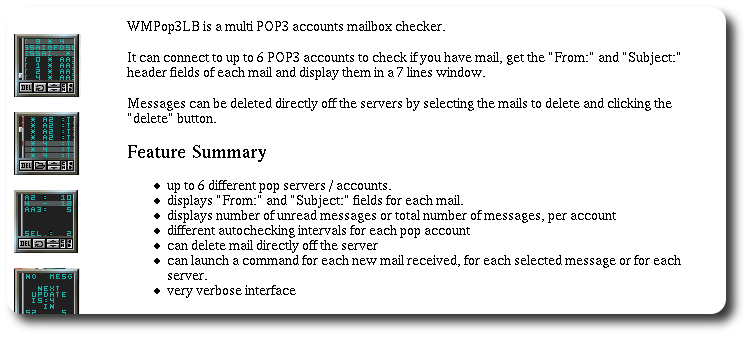
If you're not familiar with the concept of dockapps (from the wikipedia entry):
Dockapps, or docked applications are computer programs which appear to reside inside an icon rather than a window in graphical computer systems. Their display is constantly-updated just like a windowed application, but appears inside a small (64x64 pixel) icon.
This makes dockapps particularly suitable for monitoring things in the background
Dockapps were heavily used in the
NextStep Operating system, which was later cloned into
WindowMaker(still actively developed), which became a popular window manager (before Gnome and KDE stole the spotlight.) Many window managers support dockapps in some way or another these days, including KDE, which has a special dockapp toolbar you can add (rightclick on your panel, add new panel, dock application bar) and Gnome, in which dockapps can be used in the gnome-swallow-applet.
Fluxbox, supports dockapps through it's 'slit' bar, etc,...
There is an amazing amount of information and gui interface you can squeeze into such a little icon, and it's great that all these window managers have their own way of handling/displaying and interacting with these dockapps, so using them makes them truly integrated into your window manager/desktop.
I particularly enjoy this little dockapp, because next to just displaying information (latest emails you received, etc), it can also be interactively used to delete messages from the server, or launch any application depending on the message/pop3 server. This allows you to play a different sound or append different parameters to your email application, or run any creative command you can come up with.
If you take a look on it's website, you'll notice it is VERY customizable, and an amazing amount of functionality is hiding behind such a little interface!
I use it together with
wmnetmon which allows me to monitor different services (eg: pop3, http, smtp, etc,...) on different servers, and also lets me run a custom command/program when a problem occurs with one of the servers.
The commands to run when a new mail has arrived allow you to pass about all information about the received email(s) to any command/program. This makes it very easy to make a little proxy program or script which will read the parameters, do something with them, and then pass it to your mail program. You could write your own personal/advanced spam filtering or email sorting/alerting program/script extremely easy this way.
